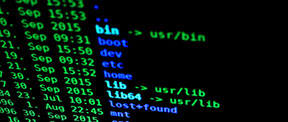**Exploring the Command Line: Uncovering the Power of locate**
In the vast realm of Linux commands, there lies a hidden gem known as locate. This unassuming tool possesses the remarkable ability to swiftly locate files and directories based on their names. Its versatility and ease of use make it an invaluable asset for system administrators, programmers, and anyone navigating the labyrinthine depths of their file systems.
**Unveiling the locate Command’s Essence**
At its core, locate operates by maintaining a database of file and directory names. This database, commonly known as the locate database, is meticulously updated on a regular basis by a dedicated utility called updatedb. The database resides in a designated directory, typically /var/lib/mlocate, and serves as the foundation for locate’s lightning-fast searches.
**Harnessing the Power of locate: Practical Applications**
The locate command unlocks a plethora of possibilities for locating files and directories with remarkable efficiency. Its simplicity and intuitive syntax make it accessible to users of all experience levels. Let’s delve into some practical examples to showcase its true potential:
**1. Searching for a Specific File:**
To embark on a quest to locate a specific file, simply invoke the locate command followed by the file name you seek. For instance, if you’re on the hunt for a file named “important_report.pdf,” issue the following command:
“`
locate important_report.pdf
“`
locate will scour the depths of your file system and present you with a list of matching paths where the file resides.
**2. Narrowing Down the Search with Regular Expressions:**
The locate command empowers you to refine your searches using regular expressions, a powerful tool for pattern matching. By incorporating regular expressions, you can sift through your file system with surgical precision. To illustrate, let’s modify the previous example to find all files ending in “.pdf”:
“`
locate \.pdf
“`
This command will uncover all files with the “.pdf” extension, providing a comprehensive list of all PDF documents on your system.
**3. Restricting the Search to a Specific Directory:**
In situations where you know the file you seek resides within a particular directory, you can harness locate’s directory restriction capabilities. By specifying the directory path, you can confine the search to that specific location. For instance, to locate all “.txt” files within the “/home/user/Documents” directory, execute the following command:
“`
locate \.txt /home/user/Documents
“`
This targeted approach will yield a list of all “.txt” files nestled within the specified directory.
**4. Excluding Directories from the Search:**
Conversely, you may encounter scenarios where you want to exclude certain directories from the search. locate provides an elegant solution for this need. By leveraging the “-L” option, you can instruct locate to omit specific directories from its search path. Consider the following command:
“`
locate -L /tmp /var/log \.log
“`
This command will locate all “.log” files, while deliberately avoiding the “/tmp” and “/var/log” directories.
**Unleashing the Full Potential of locate**
While the aforementioned examples provide a glimpse into the capabilities of locate, it’s worth noting that there’s a wealth of additional options and flags available to further refine your searches. Consulting the locate man page (accessible via the command “man locate”) will reveal the full extent of its power.
**Conclusion: Embracing locate’s Brilliance**
In the vast arsenal of Linux commands, locate stands out as a beacon of efficiency and precision. Its ability to swiftly locate files and directories, coupled with its intuitive syntax and versatility, makes it an indispensable tool for anyone navigating the complexities of the Linux file system. Whether you’re a seasoned system administrator or a novice user, incorporating locate into your repertoire will undoubtedly enhance your productivity and streamline your file management tasks.
